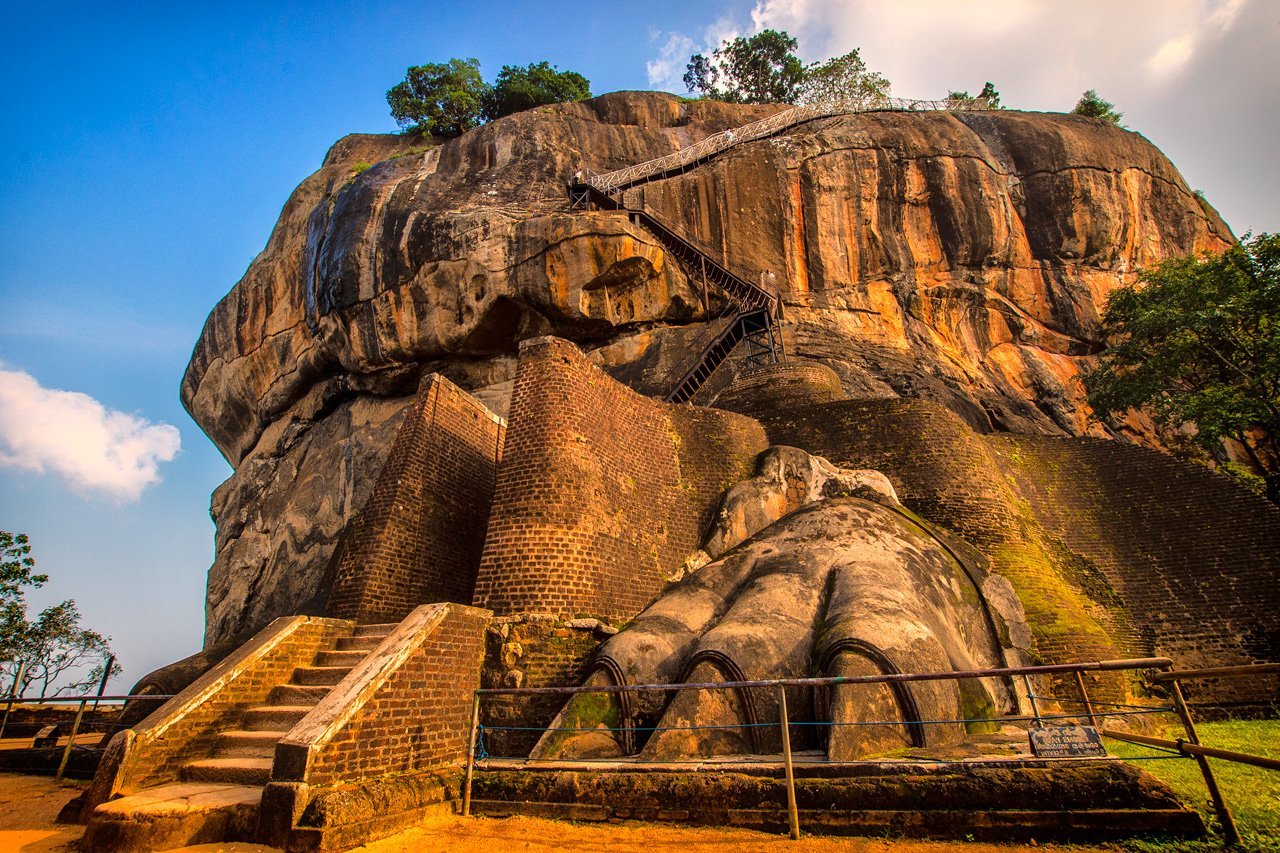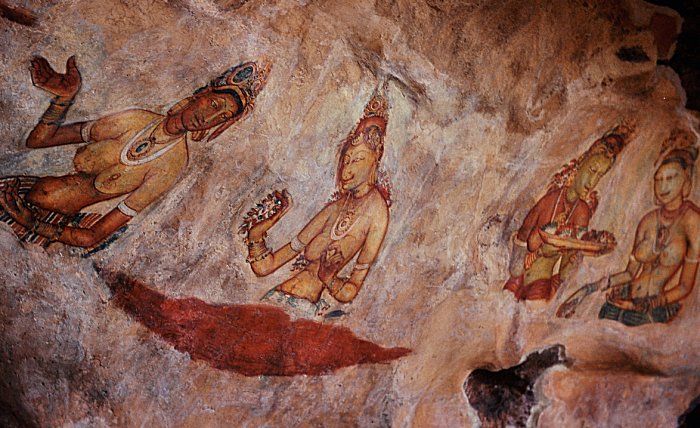Amazing ‘Sigiriya’- ‘Lion Rock’ Fortress In Sri Lanka With Frescoes, Mirror Wall And Miniature Gardens
A.Sutherland - AncientPages.com - Sri Lanka’s ancient site of historical and archaeological significance is dominated by a massive column of rock the so-called ‘Sigiriya Rock’.
Sigiriya rock (or the ‘Lion rock’) fortress is the spectacular and the oldest structure, approximately 200 meters (660 ft) high, located in the Matale District of the Central Provincen of Sri Lanka.
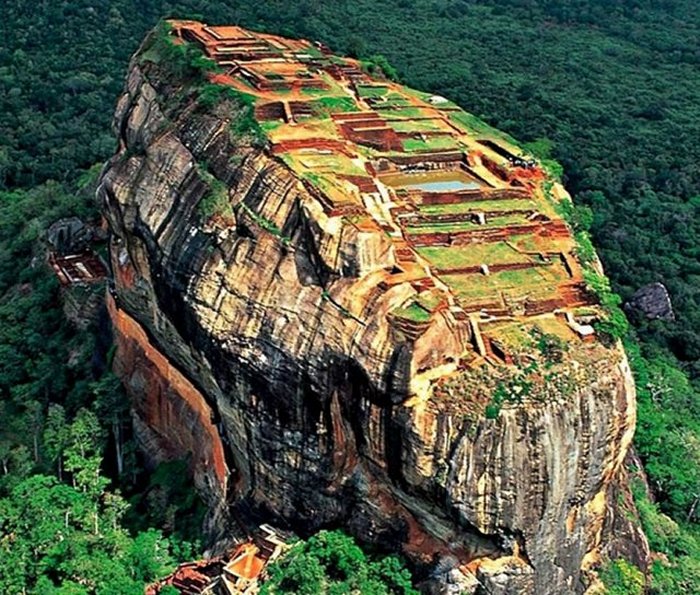
Sigiriya contains miniature water gardens and traditionmal water gardens considered to be are among the oldest in the world and their underground water ways are still functioning.
Sigiriya fortress features graffiti, frescoes, beautiful, landscaped gardens and fantastic 360-degree views. In fact, it is wrongly described as a fortress or castle but it is a perfectly planned multi-layered and complex royal city that covers several square meters in extent.
Miniature Water Gardens
According to archaeologists and historians, Sigiriya is a ‘unique combination of fifth century urban planning, hydraulic management, perfectly design landscaping, engineering, architecture, painting and sculpture.
Today the Sigiriya complex is consisted of several parts and includes ramparts, moats, pleasure gardens, frescoes, mirror Wall. Lions Paw, summit, artificial lake along with inner and outer cities, a citadel that extends about 18 sq km and seven kilometers long dam.
The ‘Lion rock’ earned its name from the enormous lion which greeted visitors halfway up the rock on a small plateau.
See also:
Mysterious Mount Roraima Rising Over 8000 Feet Into The Clouds
Yungang Grottoes: Marvellous Example Of Ancient Buddhist Rock-Cut Architecture
Great Living Chola Temples: Outstanding Workmanship Of Chola Dynasty Builders Of South India
In ancient times, the same lion carved of rock warned enemies approaching the fortress.
Sigiriya contains miniature water gardens and traditional water gardens considered to be among the oldest in the world and their underground water ways are still functioning.
History Of Sigiriya
According to the ancient Sri Lankan chronicle the 'Culavamsa', this site was selected by King Kasyapa (473 - 495 CE) for his new capital. He is credited with the construction of the Sigiriya citadel and the surrounding city.
He acquired the throne by overthrowing his father, and usurping his brother who had rightful heir to the throne, Moggallana, in a palace coup. Kasyapa imprisoned and later executed his father but later he lost his life in the battle.
He built his palace on the top of this rock and decorated its sides with colorful frescoes. On a small plateau about halfway up the side of this rock he built a gateway in the form of an enormous lion. The capital and the royal palace were abandoned after the king's death.
It was used as a Buddhist monastery until the 14th century, which is confirmed by the historical evidence but later it was lost for the jungle. During the 19th century, Buddhist monks again returned to the site and established a temple at Pidurangala.
Frescoes And Paintings Of Sigiriya
The most famous features of the Sigiriya complex are the 5th century paintings found
about the 100 meters above the ground’s level.
The technique used, is called ‘fresco’ which means to paint on the wet plaster. It is proved by a lady’s figure with three hands and another with three nipples. The painter could not erase the unsuitable hand and the extra nipple because he has painted it on a wet plaster.
However, there are several different interpretations of these maidens that simply can represent figures from the royal palace.
Mirror Wall In The Sigiriya Complex
It is said that originally this mostly unusual wall was so perfectly polished that the king could see himself whilst he walked alongside it. Made of brick masonry, the wall was covered in highly polished white plaster. This walled path continued to the summit through the lion’s mouth. The mirror wall was designed by skilled builders who used a technique that could combine natural rock, brick powder, kaolin, dolomite and oil of a bark of Dorana tree,commonly used for varnishing.
The Graffiti Tells Stories About Sigiriya
After Kasyapa's reign ended, the monastery with monks appeared again and people began to visit this
fascinating place writing poems about Sigiriya.
More than 1200 graffiti shed light on the society, literature and people who had a tradition of traveling to see the places other than on pilgrimage during the period from 6th to 13th century AD.
According to one graffiti, for instance, we learn that the queens at the time, have worn the silk from Beijing.
Lions Paw And Lion Staircase
One of the most dramatic features at Sigiriya is the great Lion Staircase, now only some ruins.
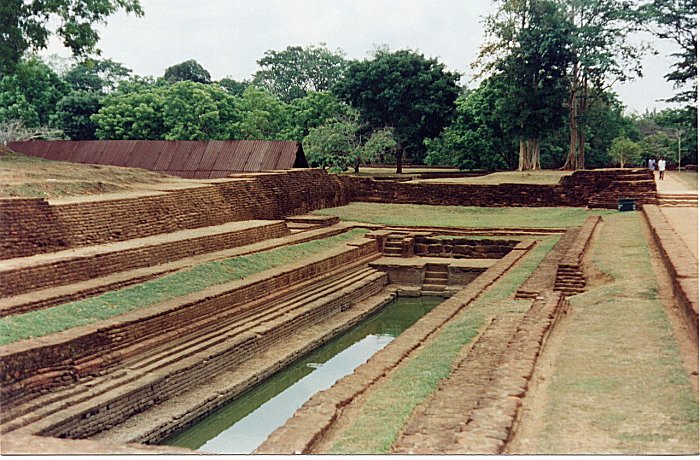
A pool in the garden complex: Sigiriya, Sri Lanka. Gardens at the foot of Sigiriya Rock. Copyright H.J.Moyes (harry@shoka.net) October 2000 via wikipedia
On a small plateau approximately halfway up this rocky structure, the king ordered to build a gateway shaped as an enormous lion. There was once a sculpted lion's head above the legs and paws on both sides of the entrance, but the head collapsed years ago. The name of the place is derived from this structure —'Sihagiri', the Lion Rock. The lion - in its ruined state - is impressive even today. The graffiti describes the great lion and the entrance.
Both the Palace on the summit of the rock structure and a gateway in the form of an enormous lion was built on orders of the king; however, he did not stay at the palace, which has been used at ceremonial occasions, instead.
“...The Palace on the summit and the great lion presided over the surrounding countryside, is a powerful expression of both actual and symbolic royal authority and control over “landscape of power” radiating across the territory of the Sigiriya kingdom....” (Bandaranayaka. S.)
In "Sigiriya: City, Palace, and Royal Gardens," Senake Bandaranayake wrote that excavations revealed a suburban settlement. Eastern side of the rock was the" metropolis of the Sigiriya complex, where the bulk of the city’s population lived – nobles, officials, traders, craftsmen soldiers, servants and slaves...”
Sigiriya is one of the best preserved examples of ancient urban planning.
Written by – A. Sutherland - AncientPages.com Senior Staff Writer
Copyright © AncientPages.com All rights reserved. This material may not be published, broadcast, rewritten or redistributed in whole or part without the express written permission of AncientPages.com
Expand for referencesBandaranayake S. Sigiriya: City, Palace and Royal Gardens
More From Ancient Pages
-
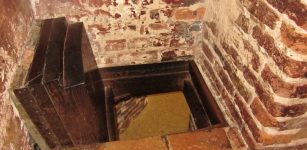 Nicholas Owen ‘Little John’ Who Paid Highest Price For His Ingenious, Camouflaged Places To Hide
Featured Stories | Dec 5, 2017
Nicholas Owen ‘Little John’ Who Paid Highest Price For His Ingenious, Camouflaged Places To Hide
Featured Stories | Dec 5, 2017 -
 Giant 4,500-Year-Old Axe Grinding Site Discovered In Scotland
Archaeology | Dec 13, 2022
Giant 4,500-Year-Old Axe Grinding Site Discovered In Scotland
Archaeology | Dec 13, 2022 -
 Jason And The Argonauts – Hate, Sorcery, Love And Jealousy Reign In This Famous Greek Story
Featured Stories | Jan 6, 2022
Jason And The Argonauts – Hate, Sorcery, Love And Jealousy Reign In This Famous Greek Story
Featured Stories | Jan 6, 2022 -
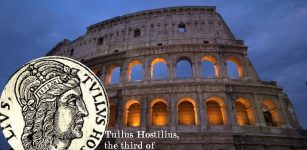 Tullus Hostilius: Warrior King Of Rome, Who Succeeded Numa Pompilius And Feared Prophecies
Featured Stories | Mar 6, 2019
Tullus Hostilius: Warrior King Of Rome, Who Succeeded Numa Pompilius And Feared Prophecies
Featured Stories | Mar 6, 2019 -
 Mysterious Lost Tartessian Civilization And Its Ancient Tablet With Paleo-Hispanic Alphabet
Archaeology | Jun 15, 2024
Mysterious Lost Tartessian Civilization And Its Ancient Tablet With Paleo-Hispanic Alphabet
Archaeology | Jun 15, 2024 -
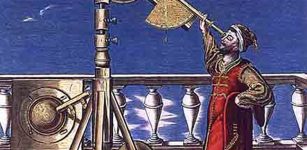 Eclipse Was A Bad Omen, A Sign Of Gloom And Doom In Ancient Peoples’ Beliefs
Featured Stories | Sep 25, 2015
Eclipse Was A Bad Omen, A Sign Of Gloom And Doom In Ancient Peoples’ Beliefs
Featured Stories | Sep 25, 2015 -
 God Loki – Trickster, Elusive And Fascinating Member Of The Norse Pantheon
Featured Stories | Sep 14, 2017
God Loki – Trickster, Elusive And Fascinating Member Of The Norse Pantheon
Featured Stories | Sep 14, 2017 -
 Are The Strange Lawrence Brook Carvings In New Jersey A Cryptic Message?
Featured Stories | Feb 10, 2023
Are The Strange Lawrence Brook Carvings In New Jersey A Cryptic Message?
Featured Stories | Feb 10, 2023 -
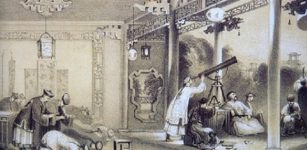 On This Day In History: Sunspot Observed By Chinese Astronomers During The Han Dynasty – On May 10, 28 BC
News | May 10, 2016
On This Day In History: Sunspot Observed By Chinese Astronomers During The Han Dynasty – On May 10, 28 BC
News | May 10, 2016 -
 Historic Shipwreck Mentor Reveals Its Underwater Secrets
Archaeology | May 14, 2022
Historic Shipwreck Mentor Reveals Its Underwater Secrets
Archaeology | May 14, 2022 -
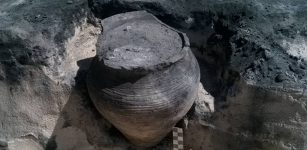 Extraordinary Discovery: Clay Vessel With Sour Soup For The Gods Found In Medieval Hut
Archaeology | Jun 4, 2017
Extraordinary Discovery: Clay Vessel With Sour Soup For The Gods Found In Medieval Hut
Archaeology | Jun 4, 2017 -
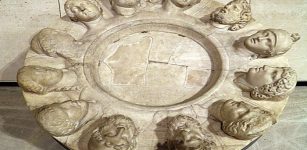 ‘Altar Of Twelve Gods’ At Gabii, Italy Was Once An Important Ancient Place
Civilizations | Apr 1, 2023
‘Altar Of Twelve Gods’ At Gabii, Italy Was Once An Important Ancient Place
Civilizations | Apr 1, 2023 -
 Mystery Of The Man Whose Supernatural Abilities Still Captivate Scientists
Featured Stories | Jan 16, 2023
Mystery Of The Man Whose Supernatural Abilities Still Captivate Scientists
Featured Stories | Jan 16, 2023 -
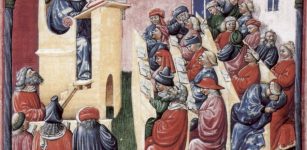 What Was It Like To Be A Student In The Middle Ages?
Ancient History Facts | Jun 6, 2019
What Was It Like To Be A Student In The Middle Ages?
Ancient History Facts | Jun 6, 2019 -
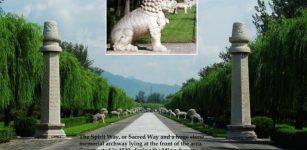 Amazing Thirteen Ming Tombs: Gigantic Stone Animals And Human Figures Were Symbols Of Royal Power
Civilizations | Oct 1, 2018
Amazing Thirteen Ming Tombs: Gigantic Stone Animals And Human Figures Were Symbols Of Royal Power
Civilizations | Oct 1, 2018 -
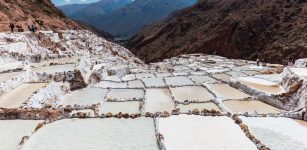 Astonishing Pre-Inca Salt Ponds of Maras In Peru Were Created By The Chanapata Culture
Civilizations | Sep 14, 2016
Astonishing Pre-Inca Salt Ponds of Maras In Peru Were Created By The Chanapata Culture
Civilizations | Sep 14, 2016 -
 Unique 1,600-Year-Old Gold Bead Found By Teenager In Jerusalem’s City Of David
Archaeology | Feb 9, 2023
Unique 1,600-Year-Old Gold Bead Found By Teenager In Jerusalem’s City Of David
Archaeology | Feb 9, 2023 -
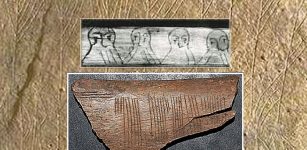 Mysterious Viking Code Jötunvillur Deciphered By Norwegian Researcher
News | Feb 24, 2014
Mysterious Viking Code Jötunvillur Deciphered By Norwegian Researcher
News | Feb 24, 2014 -
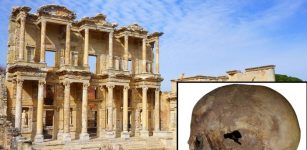 Mystery Of The Ancient Skull Found In Ephesus Solved – It Did Not Belong To Arsinoë IV, Cleopatra’s Sister
Archaeology | Jan 10, 2025
Mystery Of The Ancient Skull Found In Ephesus Solved – It Did Not Belong To Arsinoë IV, Cleopatra’s Sister
Archaeology | Jan 10, 2025 -
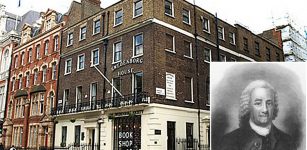 Swedenborg: Man Of Unaccountable Talents, Scholar, Great Intellect And His ‘Spiritual Awakening’
Featured Stories | Jun 28, 2018
Swedenborg: Man Of Unaccountable Talents, Scholar, Great Intellect And His ‘Spiritual Awakening’
Featured Stories | Jun 28, 2018

